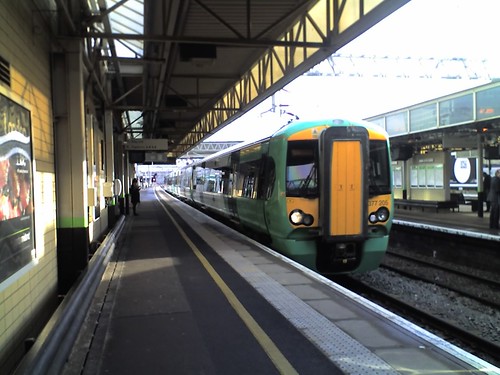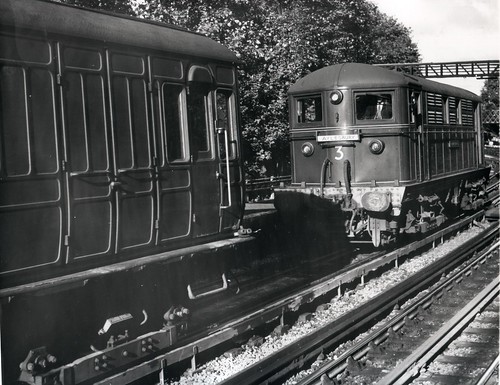
Once the present orders for Britain's trains have been delivered, a new series of designs will be launched. Trains such as the Adtranz Electrostar (above), for local services, were a development of the British Rail Networker, which came into service in the early 1990s, whilst large numbers of suburban trains were also purchased from the German manufacturer Siemens. The first came into service around 2000, and after prolonged teething troubles are performing reasonably well, apart from chronic problems like unreliable toilets, and uncomfortably bouncy, or uncomfortably hard, riding. But in comparison with the trains they replaced, dating from the 1950s, they are heavier, harder on the track and guzzle electricity, so there is plenty of scope for something better.
The next generation of long distance trains, the Inter City Express (IEP), was specified by the Department for Transport and that contract has been awarded to Hitachi. This is a hybrid electric/diesel train which can run on both electrified and non-electrified lines. The concept sounds wonderful but in practice, it means that an electric locomotive is being dragged unnecessarily over lines that are not electrified, and a diesel locomotive is being dragged unnecessarily over lines with an electric power supply. Worse still, the diesel locomotive will not be powerful enough to maintain the same schedules as the Inter City 125 trains, and over electrified lines the diesel will be needed to provide additional traction over some of the route.
The DfT defends the design and has invented all sorts of post-hoc arguments in its favour, but the real reason it has come about is because the civil servants could not comprehend the time-honoured practice of changing locomotives to haul trains over lines that were not electrified. This was the way that the Metropolitan Line was operated for over 50 years until the route was electrified all the way to Amersham in 1960; an electric locomotive hauled the train to the change-over point and a steam locomotive took the train on. The switch was made at Rickmansworth (below) and took just two minutes, so this was hardly a difficult thing. 
Much the same was done on the Waterloo-Weymouth route as the line was originally electrified only as far as Bournemouth. It would have been the obvious way to run the London to Aberdeen service: an electric locomotive would push the train to Edinburgh, where the train would split, with the front portion being hauled onwards to Aberdeen by a diesel locomotive.
Expensive follies
These are expensive follies. The prices for rolling stock have spiralled. Mark 1 stock cost about £6000 per non-powered (hauled) vehicle in the early 1960s, about £250,000 in present-day terms. The first of the Electrostars cost about £750,000 million per vehicle, and the current price is about £1.25 million. The next generation of trains will be even more expensive, with the Hitachi trains costing an astonishing £5 million per vehicle. With trains costing so much, the railways are forced to operate with a minimum of spare capacity, whilst passengers have to be crammed in as tightly as possible if fares are to be kept to reasonable levels. Which explains why, for instance, the seat spacing on mark 1 stock was 92 cm with some 3-a-side compartments, considerably more than in recent designs.

The cramped interior of a refurbished HST
Nothing works with anything else
A curious feature of all the new trains is that the different types are mutually incompatible; in the case of Electrostars, units are unable to operate together if they have different versions of the software! Few are operationally compatible and in many instances, different designs of couplings mean that vehicles of different types cannot be joined even in an emergency. A further complication relates to running long trains on routes with short platforms. This is possible but difficult because nobody has yet come up with a simple system for ensuring that passengers do not open doors where there is no adjacent platform; the system adopted uses satellite positioning and a database!
Not just a UK problem
The problem is not confined to the UK's railways. The same trend has occurred throughout Europe, with trains become ever more costly and complex, and with seating being crammed in ever more tightly. Part of this trend, which has been going on since the 1970s, has been the substitution of locomotive-hauled carriages by fixed-formation trains, such as the British Inter-City 125 and Voyager, the French TGV and the Swedish X2000. The great drawback of such trains is that carriages cannot be added or taken out of the train very easily, which makes it hard to match the number of carriages to the number of passengers likely to travel. Trains are typically made up to a minimum size and the seats sold under some complex scheme with a few bargains available for those who book in advance and extortionate fares for those who are not in a position to commit themselves to travelling at a particular time.
Of course, having to travel on a pre-booked train means that passengers have to allow generous margins for delays, which effectively wipes out much of the advantage of the shorter journey times that have been achieved with today's faster trains.
Rail travel is in need of a radical re-think.
Kommentarer